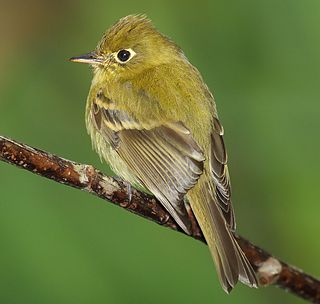
The tyrant flycatchers (Tyrannidae) are a family of passerine birds which occur throughout North and South America. They are considered the largest family of birds known to exist in the world, with more than 400 species. They are the most diverse avian family in every country in the Americas, except for the United States and Canada. The members vary greatly in shape, patterns, size and colors. Some tyrant flycatchers may superficially resemble the Old World flycatchers, which they are named after but are not closely related to. They are members of suborder Tyranni (suboscines), which do not have the sophisticated vocal capabilities of most other songbirds.

The genus Empidonax is a group of small insect-eating passerine birds in the tyrant flycatcher family, the Tyrannidae. The genus name Empidonax is from Ancient Greek empis, "gnat", and anax, "master".

The shrike-tyrants are a genus, Agriornis, of birds in the tyrant flycatcher family Tyrannidae. The members of this genus are found in open habitats in western and southern South America, usually at high elevations. They are large and heavy billed by tyrant-flycatcher standards, and include the largest representative of the family, the great shrike-tyrant. These five species all have a dull brownish or greyish plumage. Despite their name any similarity with the shrikes is superficial. Many field guides note their greater resemblance to thrushes.

Alectrurus is a genus of South American birds in the tyrant flycatcher family Tyrannidae.

Casiornis is a genus of South American birds in the tyrant flycatcher family Tyrannidae.

Conopias is a genus of birds in the tyrant flycatcher family Tyrannidae.

Euscarthmus is a genus of South American birds in the tyrant flycatcher family Tyrannidae.

Mecocerculus is a genus of birds in the large tyrant flycatcher family Tyrannidae.

Myiopagis is a genus of bird in the family Tyrannidae, the tyrant flycatchers. These species are closely related to the genus Elaenia but are generally smaller.

Myiophobus is a genus of birds in the tyrant flycatcher family Tyrannidae.

Myiotheretes is a genus of South American birds in the tyrant flycatcher family Tyrannidae. These superficially thrush-like birds are large tyrants of the Andean highlands. The red-rumped bush tyrant is considered closely related.

Ornithion is a genus of birds in the large tyrant flycatcher family Tyrannidae.

Nesotriccus is a genus of Central and South American birds in the tyrant flycatcher family Tyrannidae.

Phyllomyias is a genus of small birds in the tyrant-flycatcher family Tyrannidae. They are found in wooded habitats of Central and South America. Some species are among the commonest birds in their range, while other are rare and threatened. They have a short, stubby bill, are greenish above, yellowish or whitish below, and all except the sooty-headed tyrannulet have pale wing-bars or edging. They feed on small arthropods and fruits. Most species regularly take part in mixed species flocks.

Rhytipterna is a genus of bird in the tyrant flycatcher family Tyrannidae. They share the common name "mourner" with several species in the family Tityridae.

Serpophaga is a genus of birds in the tyrant flycatcher family Tyrannidae that are found in Central and South America.

Sublegatus is a genus of birds in the tyrant flycatcher family Tyrannidae.

Anairetes is a genus containing the tit-tyrants, a group of small, mainly Andean birds, in the tyrant flycatcher family Tyrannidae. The group briefly included the genus Uromyias, which had been recognized based on syringeal and plumage characters, including a flatter crest and a longer tail, but was included within Anairetes due to genetic analysis. Recent analyses suggested splitting into Uromyias again. Anairetes is believed to be most closely related to the genera Mecocerculus and Serpophaga; however, there is no definitive evidence supporting this claim.

Nephelomyias is a genus of birds in the tyrant flycatcher family Tyrannidae. It contains the following three species:

Sirystes is a genus of birds in the tyrant flycatcher family, Tyrannidae. They used to be all considered conspecific. Vocal differences primarily separated the superspecies into four distinct taxa.





























